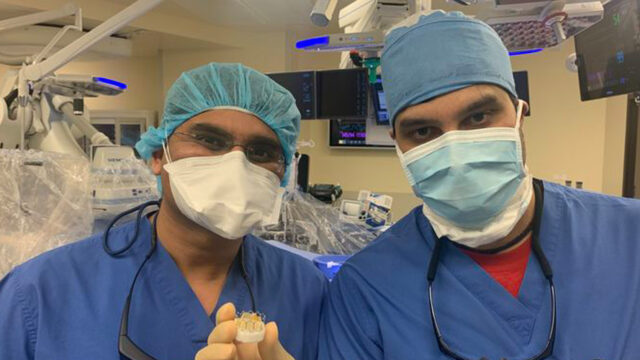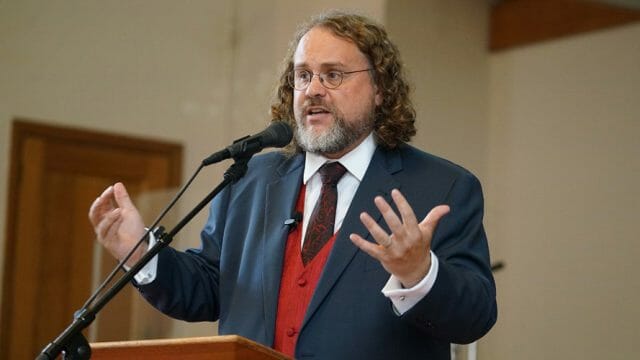The eternal gospel in the first angel’s message

Sunday
Angels descended on the city of Bethlehem proclaiming the good news of the birth of the Savior (Luke 2:8-11), and now shortly before the coming of Christ angels come again proclaiming the saving power of the eternal gospel. As a matter of fact, within the messages of the three angels (Rev. 14:6-12) the gospel functions as their bookends: the eternal gospel is mentioned at the beginning (verse 6), and at the end we find faith in the saving work of Jesus—justification by faith (verse 12). The first angel proclaims the gospel in the context of God’s final judgment; the second announces the triumph of the eternal gospel in the collapse of Babylon’s false gospel (verse 8); the third announces the final judgment, when evil powers will acknowledge the love and justice of God revealed through the Lamb (verse 10).
GOSPEL, LOVE, CONFLICT
The emphasis on the gospel found throughout the messages means that “of all professing Christians, Seventh-day Adventists should be foremost in uplifting Christ before the world”¹—a most serious challenge. We will highlight three characteristics of the gospel in the message of the first angel.
THE ETERNAL GOSPEL OF DIVINE LOVE
The gospel is eternal, for it was conceived in the divine mind in eternity and was manifest within history through Jesus Christ (Rom. 16:25, 26; Col. 1:26, 27). It is eternal, for it is unalterable and has permanent saving power. In Revelation the gospel encompasses all God did for us through Jesus Christ, including His substitutionary death, resurrection (Rev. 1:18), ascension (Rev. 12:5), and enthronement (Rev. 4 and 5); His work of mediation in heaven (Rev. 8:3, 4); and His return in glory to consummate the salvation of His people and to judge the wicked (Rev. 1:7; 14:10; 19:11; 22:20). John takes us to the very depth of the gospel manifested on the cross of Christ.
The gospel first appears at the beginning of Revelation when John offers a doxology to Jesus: “To Him who loves us and released us from our sins by His blood” (Rev. 1:5).² What is beyond the full comprehension of any creature has happened, and for them it is good news! This is about love and blood; about the God who went through the valley of death making atonement for us; cleansing us from sin. This is divine love made visible within history. Notice that the verb is in the present—“who loves us”—indicating the constant flow of divine love toward us. According to John, this unique love was manifested in the sacrificial death of His Son on the cross (notice the past tense—“released us”). Love, taking the form of a bloody sacrifice, broke the power of sin and freed us to serve God.
THE LAMB AND THE GOSPEL
It is the figure of the Lamb that was slain, however, that dominates the saving message of Revelation. His first appearance in the book is dramatic and powerful. God is sitting on His majestic throne with a sealed book in His hand that could only be opened by the Lamb that was slain (Rev. 5:1-6). The angel calls Him “the Lion” from the tribe of Judah, a messianic title (verse 5), but when John turns to look at the Lion, he sees “a Lamb standing, as if slain” (verse 6). The good news is that the Lion will vanquish God’s enemies by becoming a Lamb, a sacrificial Lamb. Yes, there is force and power here, but it’s the force of a Lamb that was slain, that is to say, the power of God’s love displayed on the cross. When those around the throne see the Lamb, they fall down to worship Him while singing, “Worthy are You . . . for You were slain, and purchased for God with Your blood men from every tribe and tongue and people and nation” (verse 9). Once more we find together the two fundamental concepts of blood and redemption through which God extends to repentant sinners a glorious future.
In Revelation 7:9-15 God’s end-time people stand before the throne of God and the Lamb, praising them and ready to serve them. They are standing before God and the Lamb because “they have washed their robes and made them white in the blood of the Lamb” (verse 14). The sacrifice of the Lamb not only redeems human beings but also cleanses them from their sins. In fact, it’s redemption from the power of sin that makes it possible for us to be in His presence and to serve God. Since the sacrificial death of the Lamb accomplishes this glorious liberation, it is now possible for us to join the Lamb in the cosmic conflict against the dragon and to “overcome him because of the blood of the Lamb and because of the word of their testimony” (Rev. 12:11). Two elements in their proper sequence: victory made possible through the sacrifice of Christ and witnessing on behalf of what God has done for us through the Lamb. In Revelation the Lamb is the embodiment of the eternal gospel.
GOSPEL AND CONFLICT
The proclamation of the gospel occurs in a context of conflict. It’s part of a story of rebellion that originated in heaven (Rev. 12:7, 8) and that captured the human race (Gen. 3:1-8). As the end of the conflict approaches, the dragon gets ready to overcome God’s people through deception and persecution (Rev. 13:13-15). He unifies apostate Christianity (verses 1-17) and through the message of three demonic spirits (spiritualism) gains the support of the kings of the earth (Rev. 16:13, 14). At the same time, through the messages of the three angels, God is gathering His end-time people from every nation, tribe, tongue, and people (Rev. 14:6-12) in preparation for the return of Christ (verses 14-20). In this final conflict victory is possible only through the blood of the Lamb (Rev. 12:11).
CONCLUSION
The gospel is to be proclaimed throughout the planet as the only solution to the cosmic conflict. The three angels “represent those who receive the truth, and with power open the gospel to the world.”³ We are unveiling here what is at the heart of the Adventist message—the gospel. We should never be distracted from proclaiming the sufficiency of the blood of the Lamb though word and action. We need to have a clear comprehension of the gospel, but we also need to allow it to be incarnated in our lives, making us loving people in service to others. Our churches and institutions should be places where the love of the Lamb is displayed in lives totally dedicated to Him.
Questions for Reflection:
- Why is it so important to see the gospel in the messages of the three angels?
- Are you afraid of Revelation’s message of judgment? Why or why not?
- How can we communicate effectively the Lamb and the gospel in the book of Revelation in a secular world?
¹ Ellen G. White, Evangelism (Washington, D.C.: Review and Herald Pub. Assn., 1946), p. 188.
² All Scripture quotations have been taken from the New American Standard Bible, copyright © 1960, 1962, 1963, 1968, 1971, 1972, 1973, 1975, 1977, 1995 by The Lockman Foundation. Used by permission.
³ The Seventh-day Adventist Bible Commentary, ed. F. D. Nichol, rev. ed., Ellen G. White Comments (Washington, D.C.: Review and Herald Pub. Assn., 1980), vol. 7, p. 979.








